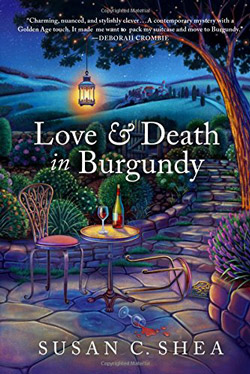
What was I thinking? When I decided to write a novel about an American couple that moves to rural France on a whim and must figure out how to fit into the local community, I didn’t think through the storytelling complications.
She speaks French well enough, although much of it is “school” French, not idiomatic. He speaks not a word of the language and seems to think he can make himself understood with hand gestures. The inhabitants of this small pastoral place speak French—well, of course they would, wouldn’t they? And then I added the coup de grace (as they say in French), a young woman born and raised in London.
Writing dialogue became a challenge. If all of your characters share a language—like Cara Black’s wonderful Parisian Aimee Leduc series—the reader intuits that everyone’s speaking in French and that the characters understand each other as they share clues, threats, and strategies. Martin Walker’s Dordogne region series about Bruno Courrèges is lucky that way too. I am also a great fan of Fred Vargas, a French novelist (Fred being a woman in this case, if you didn’t know) whose crime fiction books are available in translation, which means they were speaking amusingly in French but have shifted to all-English for my enjoyment.
But I dug myself a deep hole by writing in English about Americans who must communicate with people who speak French almost exclusively. I needed to remind readers, now and then, that Katherine was speaking in French in this scene and that some of her French neighbors were trying out a bit of English when they responded. The dialogue between characters is even more complicated on the page than it is when I visit France with my hesitant and constricted French and the polite native speakers I meet try to help me by speaking English. Perhaps some readers have been in the same position as I was, and as Katherine was, and they will recognize the rhythm.
 My editors at Minotaur were patient as I battered out a somewhat systematic approach. People speaking French in Love & Death in Burgundy frequently use a French expression as they begin to speak, translated in Katherine’s head as she listens, and Katherine will think or say something that makes it clear she is speaking French too. As in real life, speakers switch back and forth in the course of a conversation, and the writer’s trick is to keep the mechanics from overshadowing what they’re talking about.
My editors at Minotaur were patient as I battered out a somewhat systematic approach. People speaking French in Love & Death in Burgundy frequently use a French expression as they begin to speak, translated in Katherine’s head as she listens, and Katherine will think or say something that makes it clear she is speaking French too. As in real life, speakers switch back and forth in the course of a conversation, and the writer’s trick is to keep the mechanics from overshadowing what they’re talking about.
Not confusing enough? The young English woman I mentioned uses a lot of British slang. Try being Katherine trying to translate “blimey” into American and then into French while sipping espresso and munching a croissant, and you have my writing life.
I would say never again, except that the next manuscript in the series is ready to submit. Pity my poor editor!
To learn more or order a copy, visit:
opens in a new window![]() opens in a new window
opens in a new window![]()
Susan C. Shea spent more than two decades as a non-profit executive before beginning her career as a mystery author. Susan is past-president of the northern California chapter of Sisters in Crime and secretary of the national SinC board, a member of MWA, and blogs on CriminalMinds. In addition to Love & Death in Burgundy, she is also the author of the Dani O’Rourke mystery series. Susan lives in Marin County, California and travels to France as often as she can.
